Washing an orthopedic backpack
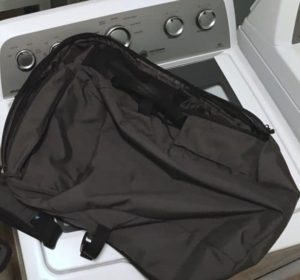 Even if worn carefully, backpacks need to be cleaned regularly, and even more so after active and playful schoolchildren. And if rag briefcases can be washed without problems, then expensive models with an orthopedic back require special care. Otherwise, not a trace will remain of the beneficial effect. Before washing your orthopedic backpack, you should understand the upcoming nuances. Where to clean, how and with what – we’ll find out right now.
Even if worn carefully, backpacks need to be cleaned regularly, and even more so after active and playful schoolchildren. And if rag briefcases can be washed without problems, then expensive models with an orthopedic back require special care. Otherwise, not a trace will remain of the beneficial effect. Before washing your orthopedic backpack, you should understand the upcoming nuances. Where to clean, how and with what – we’ll find out right now.
Be sure to study the label
Experts recommend washing your school backpack every three months for hygiene and aesthetics. However, cleaning is often required more often as children leave briefcases on the floor, grass and other dirty surfaces. In any case, the procedure will be the same.
The first step is to study the factory label. This is a small tag sewn on the inside of the backpack and briefly tells you about the features of caring for the item. As a rule, the type of possible cleaning will be specified on the label:
- hand wash only;
- Washing in a washing machine is allowed;
- Dry clean only;
- dry cleaning
The manufacturer's recommendations for caring for the item are given on the manufacturer's label.
If the product is recommended to be dry cleaned, then self-processing is prohibited. This means that the backpack does not tolerate moisture at all and needs special care. There is only one way out - to seek help from professionals.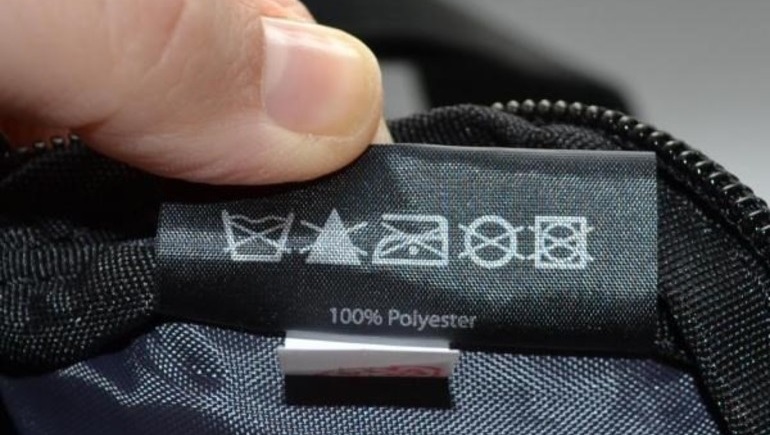
Dry cleaning is often used as an intermediate step, but for some models it becomes the only possible option. Remember that many natural materials and fabrics are not resistant to moisture. Therefore, it is important to carefully read the label and decipher all the icons on it.
Getting ready for the process
The second step is to assess the existing dirt and prepare the backpack for cleaning. Regardless of the type of wash selected, the procedure begins by emptying the contents. Having removed all the books and accessories, turn the briefcase upside down and shake out any small debris. If possible, the “insides” are vacuumed. All removable decorative elements, stripes, key rings, badges must be detached and cleaned separately.
Next, we inspect the product for damage. As a rule, before washing you have to additionally:
- fix a broken zipper;
- cut off loose threads;
- sew up torn areas.
Grass, ink, chocolate and grease stains are pre-treated with stain remover!
The next step is to begin the actual cleaning. First, use a damp cloth or sponge to collect the top layer of dust. If there are complex stains, grease, grass, ink, then you will have to wash them before the main cycle. To do this, take a suitable stain remover (not chlorine-based) and apply it in the required dosage to the affected area. Afterwards, just rub the area with a brush or leave the product for 5-7 minutes.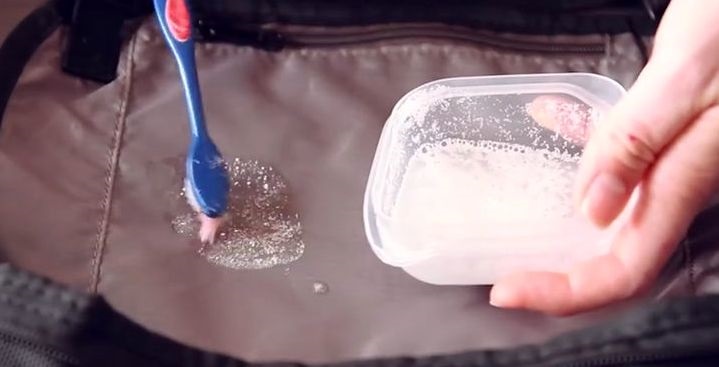
Next, we focus on the selected type of cleaning. If you plan to machine wash the backpack, then fasten all the zippers and remove the orthopedic back from the back wall. Do not forget that this insert is made of hard plastic or metal and can damage the backpack when the drum rotates. When washing by hand, on the contrary, we open all pockets.
Let's use the typewriter
For most backpacks, machine washing is fine. The main thing is to strictly follow the manufacturer’s instructions, taking into account the materials and shape of the backpack. We are talking about the following rules:
- prepare the backpack for washing and check that all compartments are closed;
- place the bag in a protective bag and load it into the drum;
- add a suitable detergent (preferably a gel or gel capsule) to the powder receptacle or drum;
- turn on the “Delicate” or “Manual” mode;

- make sure that the set temperature does not exceed 40 degrees;
- make sure that the spin cycle is turned off or reduced to a minimum;
- start the cycle.
The orthopedic backpack is washed using the “Delicate” or “Manual” program at 30-40 degrees and minimal spin.
At the end of the program, the bag is carefully removed from the drum and released from the bag. Next, it is recommended to blot the walls of the backpack with a dry cloth to speed up drying and prevent the appearance of mold. Afterwards all that remains is to dry the product.
What if the backpack cannot be wet?
It's another matter if the backpack cannot be washed. In this case, even a gentle program will not help - it is necessary to completely exclude water when cleaning. This condition applies to the following products:
- leather (both natural and artificial);
- vinyl;

- treated with special impregnations;
- having permanent decor or fixtures that cannot be wet.
If the material does not “like” water, then you will have to limit yourself to a soft sponge and a weak soap solution. When cleaning leather products, cleaning is only possible with a damp cloth.
An excellent option for dry cleaning is to use special foam cleaners. They are sold in hardware stores and allow you to remove difficult stains without contact with water. The following companies have proven themselves well:
- Silver;
- Twist;
- Liqui Moly;
- Salton;
- Saphir.
No matter how trivial it may sound, the main task when dry cleaning is to prevent excessive moisture in the material. If you have little experience, then it’s better not to risk it and go to a dry cleaner.
Removing moisture from your backpack
Washing the backpack is only half the battle. It is equally important to dry it properly. If you do not follow basic recommendations, you may lose your orthopedic bag.
The main rule when drying a backpack is to give preference to natural conditions. We proceed like this:
- do not wring out the product after washing;
- open all zippers and fasteners;
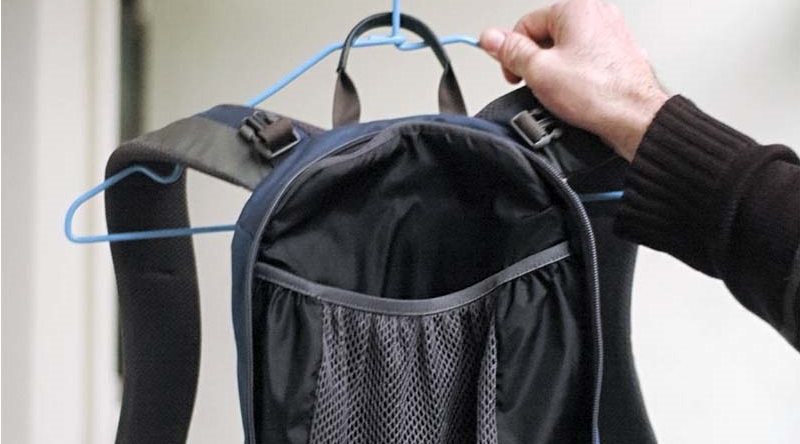
- pour out the remaining water inside the bag, turning it upside down;
- apply absorbent fabric to the walls of the backpack;
- We turn the product over again and secure it to the clothesline by the bottom and straps with clothespins.
You can speed up drying by filling all pockets and compartments with dry paper. As they get wet, the sheets are changed until all the moisture is gone. You cannot use newspapers for this task - printing ink will leave marks on the fabric. There is no need to place the orthopedic bag on a radiator or other heat source. The maximum is to hold a hairdryer nearby at a distance of at least 20 cm. But you shouldn’t dry the backpack naturally for a long time, as mold and an unpleasant odor may appear.
Advice from experienced housewives
It is better to study the manufacturer’s instructions when choosing a product so as not to create problems for yourself in the future. Luckily, most backpacks are easy and quick to clean. A few more tips will enhance the effect:
- use chlorine-free products;
- do not wash in water above 40 degrees;
- it is advisable to use liquid powders;
- handles and straps need to be cleaned harder as more bacteria accumulate on them;
- the backpack cannot be soaked;
- An unpleasant odor can be removed by rinsing in a vinegar solution.
Orthopedic backpacks are washed according to a special pattern, but with careful attention and care, cleaning will not be too burdensome. The main thing is to remember the manufacturer's recommendations.
Interesting:
Reader comments
- Share your opinion - leave a comment
Categories
Washing machine repair


For buyers

For users

Dishwasher

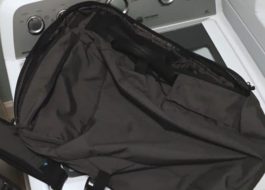
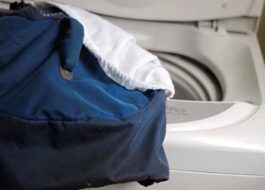














Add a comment